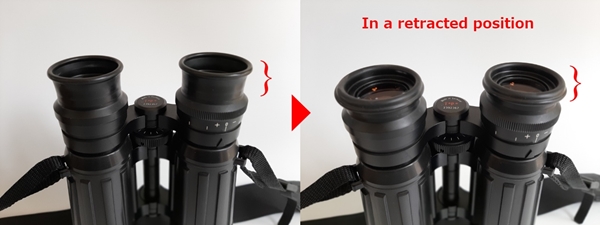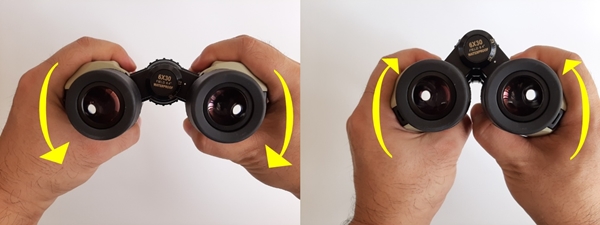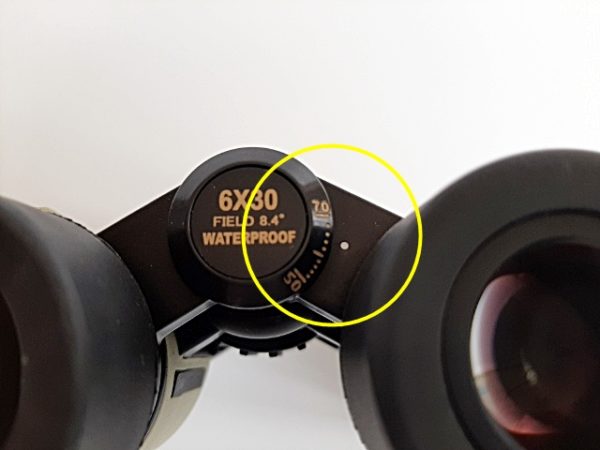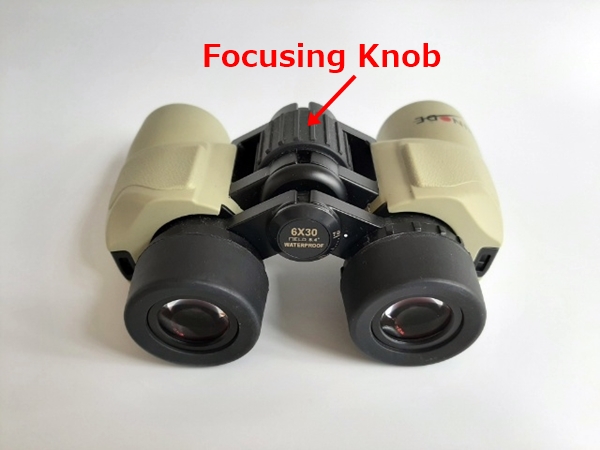When someone lets me use their binoculars, I sometimes wonder if they know how to adjust them. Even though they wear glasses, the image on one side is completely out of focus.
When I return them after correcting the diopter, they say something like, “Wow, what did you do? My binoculars work now!”
After buying binoculars, adjusting them is the first thing you should learn. The instructions usually tell you how to do it, but it’s not always clear and many people don’t take the time to read it carefully.
So, I will give you a detailed explanation on how to adjust binoculars with pictures. It’s not difficult and once you learn it, you won’t forget it.
Contents
How to adjust CF (Central Focusing) binoculars
Intuition tells me that most binocular users do not adjust their instruments properly. Even expensive binoculars such as Zeiss, Leica, and Swarovski need to be adjusted to show off their abilities.
There are two types of binoculars according to how they focus: CF (Central Focusing) and IF (Individual Focusing).

Central Focus binoculars

Individual Focus binoculars: Nikon WX7×50IF (https://www.nikon-image.com/products/sportoptics/binoculars/wx_7x50_if/)
I‘ll first explain how to adjust the CF binoculars. Once you master adjusting CF binoculars, you’ll easily understand how to adjust an IF pair.
STEP1: Adjusting the eyecups
First, to have an ideal eye point, you’ll need to adjust the eyecups. There are two types of eyecups; “Fold-up/down” and “Twist-up/down” eyecups. The most popular these days are the twist-up/down type.
- Fold up/down eyecups
Fold-up/down rubber eyecups are not used in newer binoculars. For eyeglass wearers, fold the eyecups down to a retracted position (see below).

This is because you need more distance between the ocular lens and your eye with your glasses in-between.
For non-eyeglass wearers, keep the eyecups extended to get a full field of view.
Some older binoculars do not have any eyecups. This means they have short eye relief. If you wear glasses, using this type is very difficult. (See below).

The binoculars with short eye relief (no eyecups)
- Twist-up/down eyecups
Binoculars with twist-up/down eyecups are becoming more popular. They have two major advantages: incremental height adjustment and durability.
Using twist-up/down eyecups is straightforward. Turning the eyecup counterclockwise extends its position (see below).

Turning clockwise retracts it. The height of the eyecups can be set to work perfectly for any user.
It’s important to find the position where the exit pupil (eyepoint) length is right so that you can get the entire field of view without blackout.
Eyecups also prevent your eyelashes from touching the ocular lenses. Women with lash extensions might want to choose the twist-up/down eyecups to keep the ocular lenses clean.
STEP2: Adjusting the eyepiece distance to your IPD (Interpupillary distance)
Next, you’ll need to adjust the eyepiece distance to your eyes. This easy step is necessary to align the left and right fields completely.

First, hold the binoculars with both hands and look at a distant object (200m or more). While looking at it, carefully move the barrels until both images come together as one round image.


If you get a headache or double vision, something is wrong with the collimation, which is an internal technical issue. In this case, you’d need to contact customer support.
Pro tip: if there is an IPD scale on your binoculars, you should remember your number so that you can quickly adjust them the next time.

If you have trouble adjusting the IPD while looking through your binoculars, check your IPD first with a ruler (see below).

Then, all you need to do is adjust the barrels looking at the scale.
Once you get the hang of it, adjusting the IPD takes seconds.
STEP3: Diopter adjustment
The diopter adjustment is to compensate if you have a difference in the acuity of your eyes. Without this setup, one of your eyes may see objects in focus while the other does not.
There are two steps to adjusting the diopter: focusing your left eye, then focusing your right eye.
- Focus your left eye using the focusing knob.
First, put the cap on the right objective lens so that you can only see an image with your left eye. Then, rotate the focusing knob until you get a sharp image.

- Focus your right eye with the diopter adjustment ring.
Looking at the same object, put the cap on the left objective lens so that you can only see an image with your right eye. Then, rotate the diopter ring on the right eyepiece until you get a sharp image.

Remove the cap so you can see the object with both eyes. If you can comfortably get a sharp, crisp image, the binoculars are ready to use.
If there is a scale on the diopter ring, remember your number. Even if someone else uses your binoculars, you can reset the diopter ring quickly.

STEP4: Focusing with the focus knob
Once the diopter has been adjusted, you can focus on objects at different distances by rotating the focus knob. The diopter ring stays at the same setting.


The advantage of Central Focusing binoculars is to be able to focus on objects at different distances by only rotating the focus knob.
How to adjust IF (Individual Focus) binoculars
For some binoculars, especially for marine use or astronomy, an IF (Individual Focus) system is used. In this case, there is a diopter ring on each eyepiece. That means you have to rotate both rings to focus on something.
Since it takes longer to focus on objects in a wide range of distances, IF binoculars are not ideal for birding.
However, IF binoculars are very useful for astronomy and marine use because the objects are always at infinity. Without an inner focusing mechanism like CF binoculars, it is easier to make IF binoculars waterproof and more durable.
For beginners, even if they plan to use binoculars for astronomy, I recommend they buy multi-purpose, CF binoculars.
Summary
To make full use of your binoculars’ ability, you should learn how to adjust them.
There are four steps.
First, adjust the eyecups so that you can position your eyes at the perfect eyepoint. Eyeglass wearers should fold down or twist down the eyecups. Non-eyeglass wearers should use them fully extended.
Second, move the barrels until the distance between both eyepieces fit your interpupillary distance. When they are set correctly, both of the image circles should come together as one.
Third, as your right and left eyes may have different acuity, you may need to compensate for the difference with the ‘Diopter Adjustment.’
Adjust the focus for your left eye, then your right eye. For your right eye, rotate the diopter ring on the right eyepiece.
Then, you can focus on objects at different distances by using the focus knob.
It might take a little time for beginners to master all the setup steps, but be patient. No matter how expensive your binoculars are, you won’t be able to make full use of them unless you learn how to adjust them.
